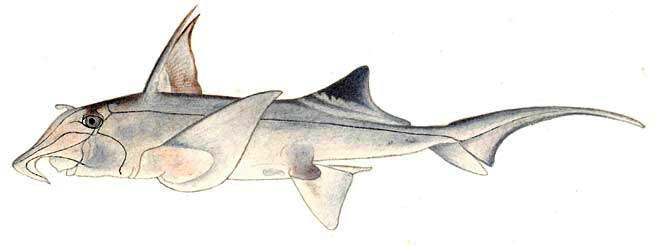|
Callorhinchus capensis (St. Joseph)
Duméril, 1865
Life
> Eukaryotes >
Opisthokonta
> Metazoa (animals) >
Bilateria >
Deuterostomia > Chordata >
Craniata > Vertebrata (vertebrates) > Gnathostomata (jawed
vertebrates) > Chondrichthyes > Holocephalii >
Chimaeriformes > Callorhinchidae
 |
|
Callorhinchus capensis (St. Joseph) [Illustration
by Ann Hecht ©] |
Identification
The hoelike snout of this silvery or bronzy
chimaera make it unmistakable. Brown markings on the flanks and
head, fin webs brown.
Size
To 1.2 m.
Range
Virtually the entire
coast from Namibia to Natal. Endemic.
Habitat
Bottom-dwelling, from
close inshore and in shallow bays to 374 m on the slope.
Biology
Abundant off the west coast and southeastern Cape but uncommon off
Natal. Eats sea urchins, bivalves, shrimp, crabs, mantis shrimp,
isopods, gastropods, and small fish (dragonets). Probably lays one
egg per oviduct at a time, these spindle-shaped and with broad flat
ribbed fins on their sides.
Human Impact
Caught by bottom trawlers,
by linefishing boats, by sports anglers, and by a directed gillnet
fishery from St. Helena Bay. Excellent eating and marketed locally
for human consumption.
Text by Leonard J.V. Compagno, David A. Ebert
and Malcolm J. Smale
|
